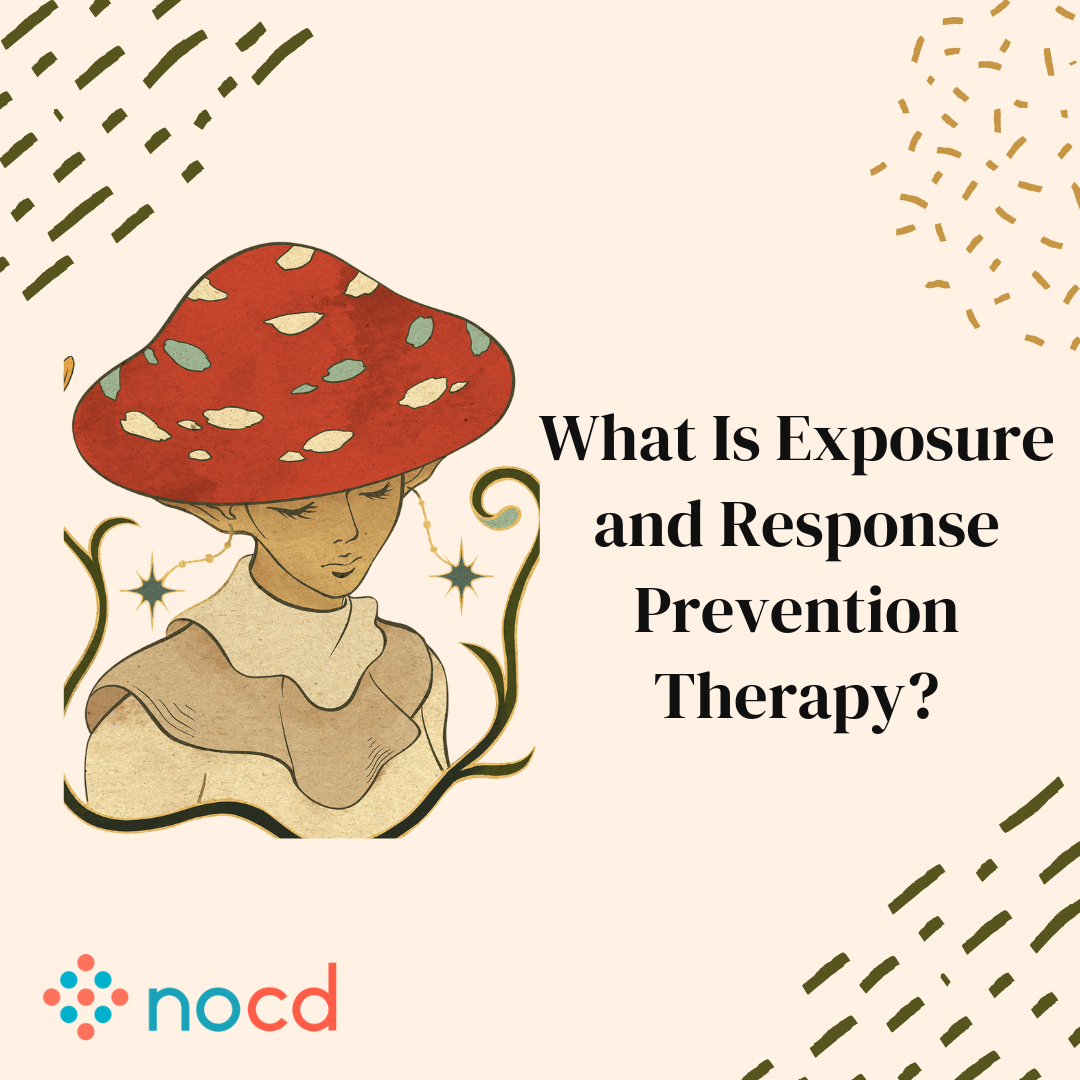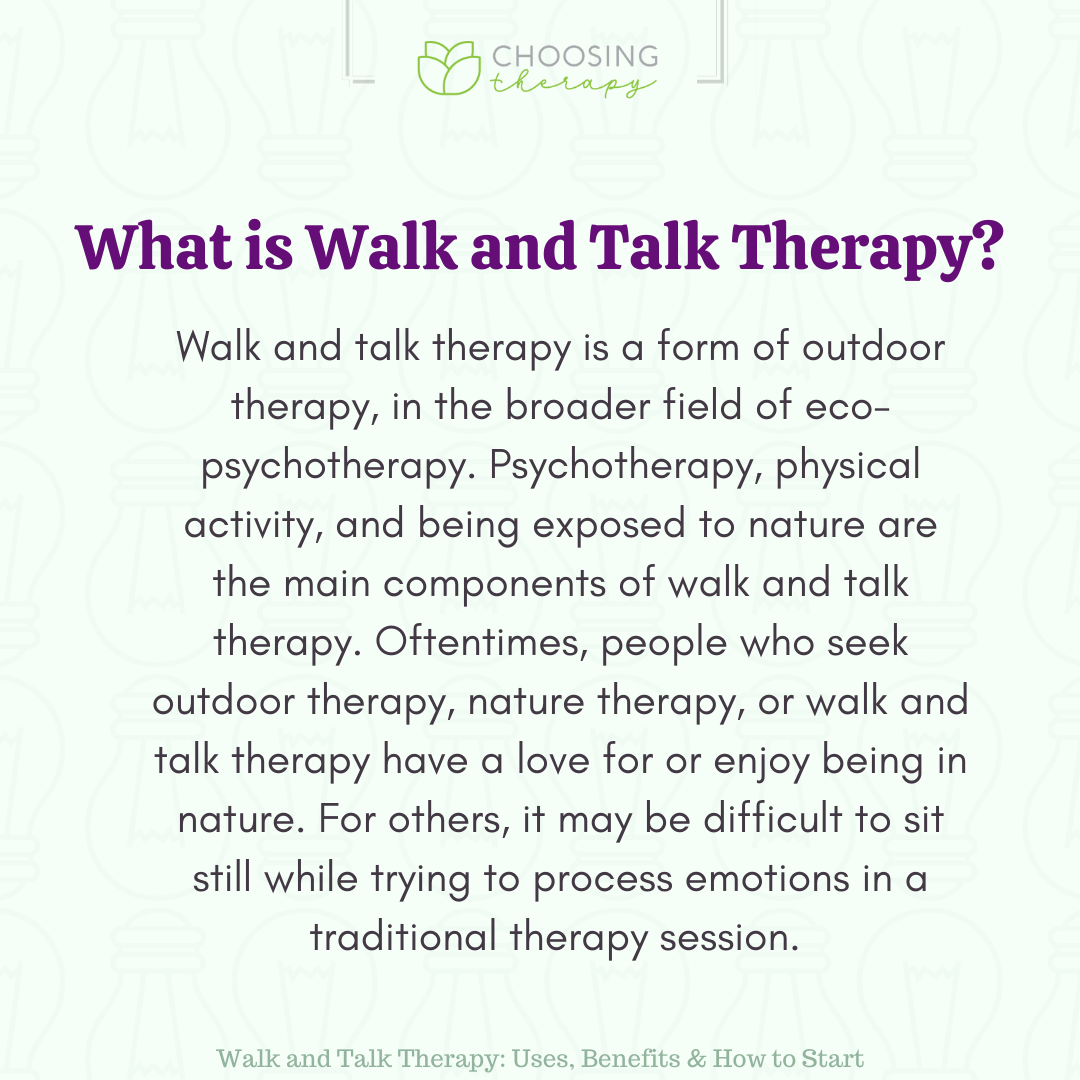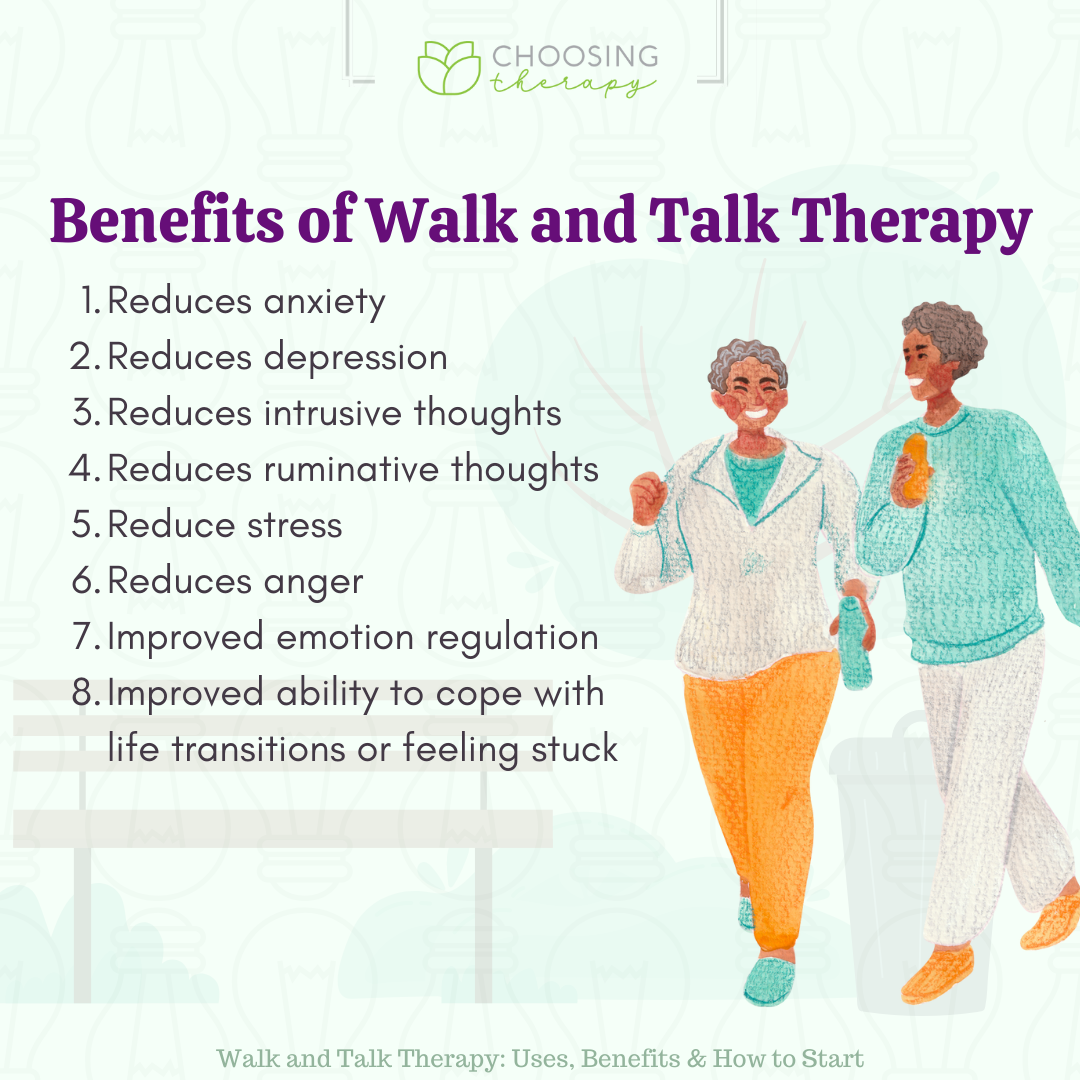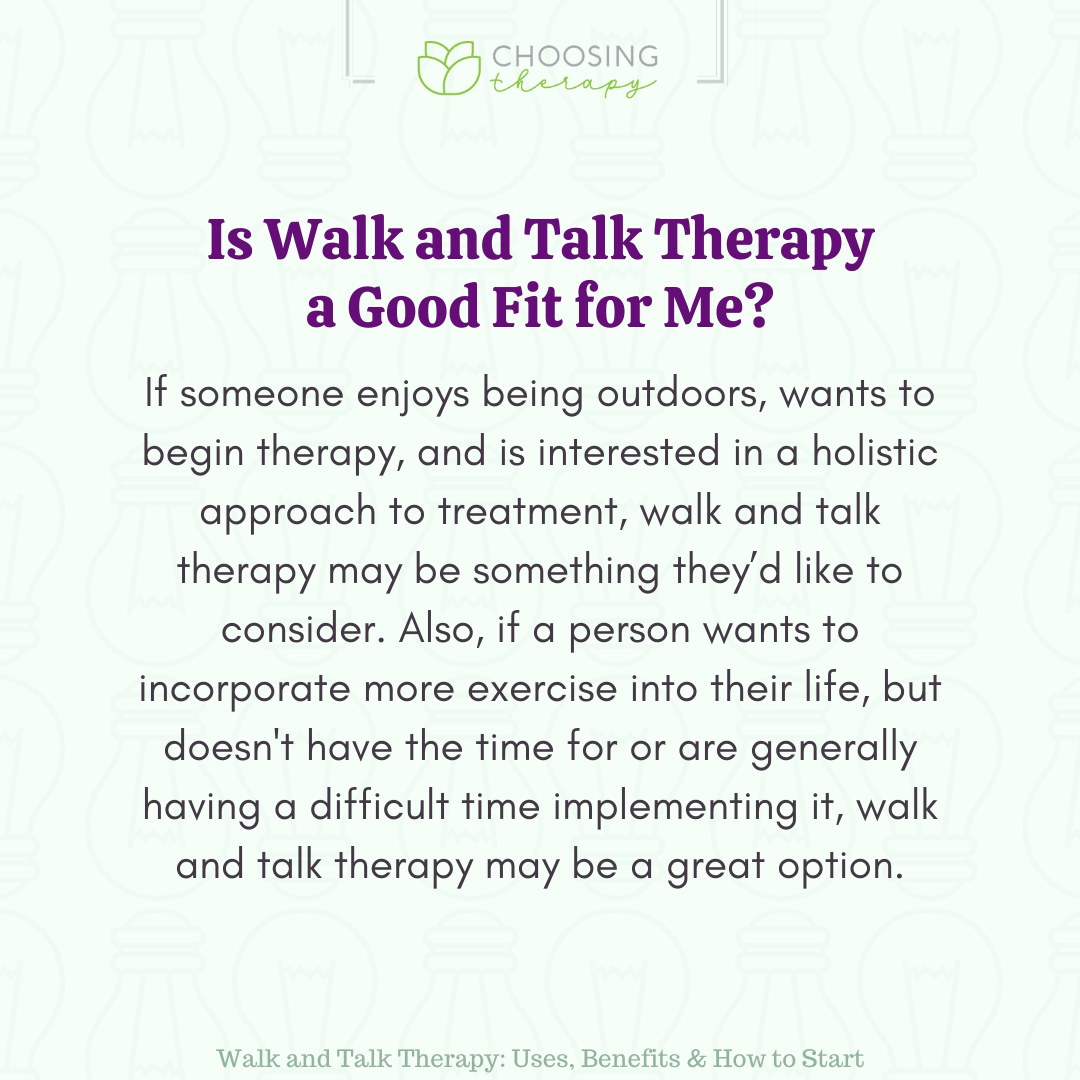Walk and talk therapy falls under the eco-psychotherapy, a combination of ‘ecology’ and ‘psychotherapy’ or ‘psychology’ umbrella.1 Sometimes viewed as a mindfulness technique or outdoor therapy, this method may be used for various clients. Walk and talk therapy can facilitate positive improvements in many mental health conditions, including anxiety, depression, and stress.
Would you like to try therapy? Find a supportive and compassionate therapist! BetterHelp has over 20,000 licensed therapists who provide convenient and affordable online therapy. BetterHelp starts at $65 per week. Take a Free Online Assessment and get matched with the right therapist for you.
What Is Walk & Talk Therapy?
Walk and talk therapy is a form of outdoor therapy and nature therapy in the field of eco-psychotherapy. Other examples of this category include adventure therapy, wilderness therapy, nature art therapy, animal-assisted psychotherapy, and horticultural (gardening) therapy.1 In sum, psychotherapy, physical activity, and exposure to nature are the main components of walk and talk therapy.2
Individuals who seek outdoor therapy, nature therapy, or walk and talk therapy often have a love for or enjoy being in nature.1 For others, it may be difficult to sit still while trying to process emotions in a traditional therapy session. Another reason someone may seek walk and talk therapy is because they do not like the sometimes awkward format of being stared at by a therapist sitting across from them. Similarly, they may come from a job in which they sit at a desk all day.1
Walk and talk therapy begins with the client and therapist meeting at a location they previously agreed upon, possibly during the initial intake session. During sessions, the client tends to lead the pace of the walk.1
Walk and talk therapy can help treat issues such as:
- Anxiety disorders
- Depression
- Self-esteem Issues
- Life transitions
- Stress
- Anger
- Bereavement
Are There Any Ethical Concerns?
Before the first walk and talk therapy session, the therapist informs the client of how confidentiality can be implemented in a natural environment. This should be a conversation between the therapist and the client and explained in the therapist’s consent forms.
Because walk and talk therapy takes place in a natural setting, there could be nearby people who can hear parts of a session. Walk and talk therapy differs from office or online treatments because the therapist and client can control their environment. Therefore, it will be important for the client to reflect on the possibility of others overhearing or witnessing them becoming emotional (i.e., crying) when discussing sensitive topics. This can help a person decide if walk and talk therapy is helpful in their mental health treatment.
8 Benefits of Walk & Talk Therapy
There are various benefits of walk and talk therapy, and it can be used in conjunction with other treatment methods for several conditions. Walk and talk therapy can positively impact symptoms of anxiety, sleep patterns, stress levels, symptoms of depression, life transitions, self-esteem, and more.3, 4
Here are eight benefits of walk and talk therapy:
1. Reduces Anxiety
Movement can help with decreasing anxiety a person may be feeling during a walk and talk session.1 A client may feel more at ease and relaxed after engaging in an active activity while simultaneously processing their thoughts, emotions, and experiences.1.
2. Reduces Depression
A recent research survey found that 71% of people engaged in a country walk felt decreased depression symptoms.4 Evidence also suggested that clients experience increased energy after engaging in walk and talk therapy.4 Fatigue is a common symptom of depression, so regaining energy could significantly benefit some clients.
3. Reduces Intrusive Thoughts
Intrusive thoughts are unwanted thoughts that cause significant distress and anxiety.5 These intrusive thoughts may include repeated doubts about one’s relationship, difficulty making decisions, questioning one’s sexual orientation or identity, or any worries and questions that do not have a definite answer.5
Intrusive thoughts could also be linked to an obsessive-compulsive disorder (OCD) or eating disorder. A nature walk can ground a person’s mind in the present moment, aiding in thought-stopping.4 Some evidence found that clients felt a sense of “centering” during and after participating in the physical experience of walk and talk therapy, helping produce clarity in thinking.2
4. Reduces Ruminative Thoughts
Ruminative thinking, otherwise known as rumination, is the tendency to think about the same thing repeatedly, often in the form of negative thoughts. The ‘walk’ part of walk and talk therapy grounds a client’s mind in the present moment, in turn decreasing rumination. The ‘talk’ aspect allows the client to process the ruminating thoughts with the therapist.
5. Reduces Stress
Exercise is known to be a method of stress management, indicating that the physical activity part of walk and talk therapy can be beneficial. There are also a variety of therapeutic modalities that can be helpful for stress reduction and teaching clients how to deal with their stress in healthy ways–many of which can be easily applied by a therapist during a walk and talk therapy session. According to experts, walk and talk therapy in outdoor environments helps the nervous system relax.1
6. Reduces Anger
There are many different types of anger one may experience. Physical activity has been shown to help with “releasing” and coping with aggression or irritation. One study found that youth who engaged in walk and talk therapy increased their ability to manage their anger.2 It also provided them with an opportunity for physical release, allowing them to better clarify their feelings.2
7. Improved Emotion Regulation
Awareness of your emotions and mind-body connection helps regulate mood or emotions. Research has shown that movement can encourage self-awareness and emotional awareness.1 Healthy emotional regulation skills include talking with a trusted person, exercising, removing oneself from a triggering situation, going to therapy, and more. These positive coping skills for emotional regulation are naturally implemented in walk and talk therapy. Sessions may also incorporate other positive coping methods for emotional regulation, like thought-challenging and positive affirmations.
8. Improved Ability to Cope With Life Transitions or Feeling Stuck
Many people go to therapy because they are at a period where they feel stuck in life. They may also have difficulty coping with a life transition or event like switching jobs, ending a relationship, moving, or bereavement. Research has suggested that walking can free a person from feeling stuck.6 Walking is a literal and physical way for the client to keep moving forward.
Top Rated Online Therapy Services BetterHelp – Best Overall “BetterHelp is an online therapy platform that quickly connects you with a licensed counselor or therapist and earned 4 out of 5 stars.” Visit BetterHelp Talkspace - Best For Insurance Talkspace accepts many insurance plans including Optum, Cigna, and Aetna. Typical co-pay is $30, but often less. Visit Talkspace
Does Walk & Talk Therapy Work?
Exercise can benefit mental health, helping improve depression, anxiety, sleep disturbances, and other physical and mental health conditions.1 Therapists implementing walk and talk therapy or other exercise and nature therapy found it can considerably benefit their clients.
One case study reported that experiences with walk and talk therapy provided “astonishing” breakthroughs regarding complex trauma.1 Furthermore, research has found that walk and talk therapy could offer a less stigmatizing therapeutic alternative to traditional indoor therapy, and clients felt it was equally or more therapeutic than the latter.1
What Does a Walk & Talk Therapy Session Include?
In addition to what may be expected in a first therapy session, a therapist will also discuss possible limitations and benefits of a session. The therapist and client will also agree on a park, walking trail, or other nature setting. Sessions typically last anywhere from 30 to 55 minutes. The length of sessions will be discussed during the first therapy session and may fluctuate based on treatment needs.
The setting in which walk and talk therapy is facilitated is essential, too.7 Case studies show that those who participated in more natural settings had greater affective and cognitive benefits than others in urban settings.7
A walk and talk therapy session may include:
- Meeting at a local park and walking side-by-side
- Meeting at a lake with a surrounding walking area and walking side-by-side
- Meeting at a hiking trail and walking side-by-side
- Walking along the water at a beach side-by-side
- Engaging in psychotherapy (talk therapy) while walking side-by-side
- Sitting near water or a landscape at moments during the session
- Brief meditation periods
Is Walk & Talk Therapy a Good Fit for Me?
If someone enjoys being outdoors, wants to begin therapy, and is interested in a holistic approach to treatment, walk and talk therapy may be something to consider. Those who want to incorporate more exercise but do not have the time for it can also benefit from walk and talk therapy.
Walk and talk therapy may be an approach for someone who is having symptoms of depression or anxiety, and would prefer to try holistic approaches over medication. Additionally, it may help those experiencing treatment-resistant depression. A person who views traditional therapy settings as daunting or unappealing may enjoy this alternative method, too. However, research suggests that walk and talk therapy is more effective for teens and adults than younger children.
What If I Don’t Like the Outdoors?
Your therapist will always work with you and discuss appropriate settings for your treatment. Maybe you’re interested in walk and talk therapy, but aren’t the biggest fan of outdoor activities like hiking or walking through wooded areas. Other options could include going to a lake or pond, walking on the beach, or even walking on the sidewalk around your therapist’s office. Just be sure to communicate with your therapist about what you are comfortable with and what works for you, and remember that your therapist is always going to prioritize that.
How to Find a Walk & Talk Therapist
It is not always easy to find the right therapist. Be sure to read through therapists’ bios, look into what approaches they utilize, and what they specialize in. Using an online therapist directory gives you the opportunity to search for therapists in your state, and filter by specific therapist specialties. You can also consult your primary physician for a therapist referral.
Final Thoughts
Walk and talk therapy marries physical activity and psychotherapy, which are both significantly impactful methods for improving a multitude of mental health symptoms. While this method may not be for everyone, if you are interested and remain open-minded, you may reap its many benefits. This type of therapeutic technique can also help decrease the stigma associated with therapy. It can teach you how to put healthy habits into practice, like exercising and enjoying nature. No matter what your fitness level or therapeutic needs are at each session, your therapist should always consider those.
To help our readers take the next step in their mental health journey, Choosing Therapy has partnered with leaders in mental health and wellness. Choosing Therapy is compensated for marketing by the companies included below. Online Therapy BetterHelp – Get support and guidance from a licensed therapist. BetterHelp has over 20,000 therapists who provide convenient and affordable online therapy. Take A Free Online Assessment and get matched with the right therapist for you. Free Assessment Online Psychiatry Hims / Hers If you’re living with anxiety or depression, finding the right medication match may make all the difference. Connect with a licensed healthcare provider in just 12 – 48 hours. Explore FDA-approved treatment options and get free shipping, if prescribed. No insurance required. Get Started Medication + Therapy Brightside Health – Together, medication and therapy can help you feel like yourself, faster. Brightside Health treatment plans start at $95 per month. United Healthcare, Anthem, Cigna, and Aetna accepted. Following a free online evaluation and receiving a prescription, you can get FDA approved medications delivered to your door. Free Assessment Starting Therapy Newsletter A free newsletter for those interested in learning about therapy and how to get the most benefits out of therapy. Get helpful tips and the latest information. Sign Up Choosing Therapy Directory You can search for therapists by specialty, experience, insurance, or price, and location. Find a therapist today.Additional Resources
What Is Exposure and Response Prevention Therapy? ERP therapy alters OCD’s pattern by addressing both obsessions and compulsions. In ERP, an individual is encouraged to confront the stimuli that trigger distress related to their obsessions while also resisting the urge to perform compulsions in an attempt to reduce their distress.
Why is ERP So Expensive? There are hundreds of OCD tests and “OCD quizzes” online. Some aim to help people self-diagnose; others turn obsessive-compulsive disorder into a joke. Either way, a vast majority of these are not helpful and probably create more problems than solutions.








